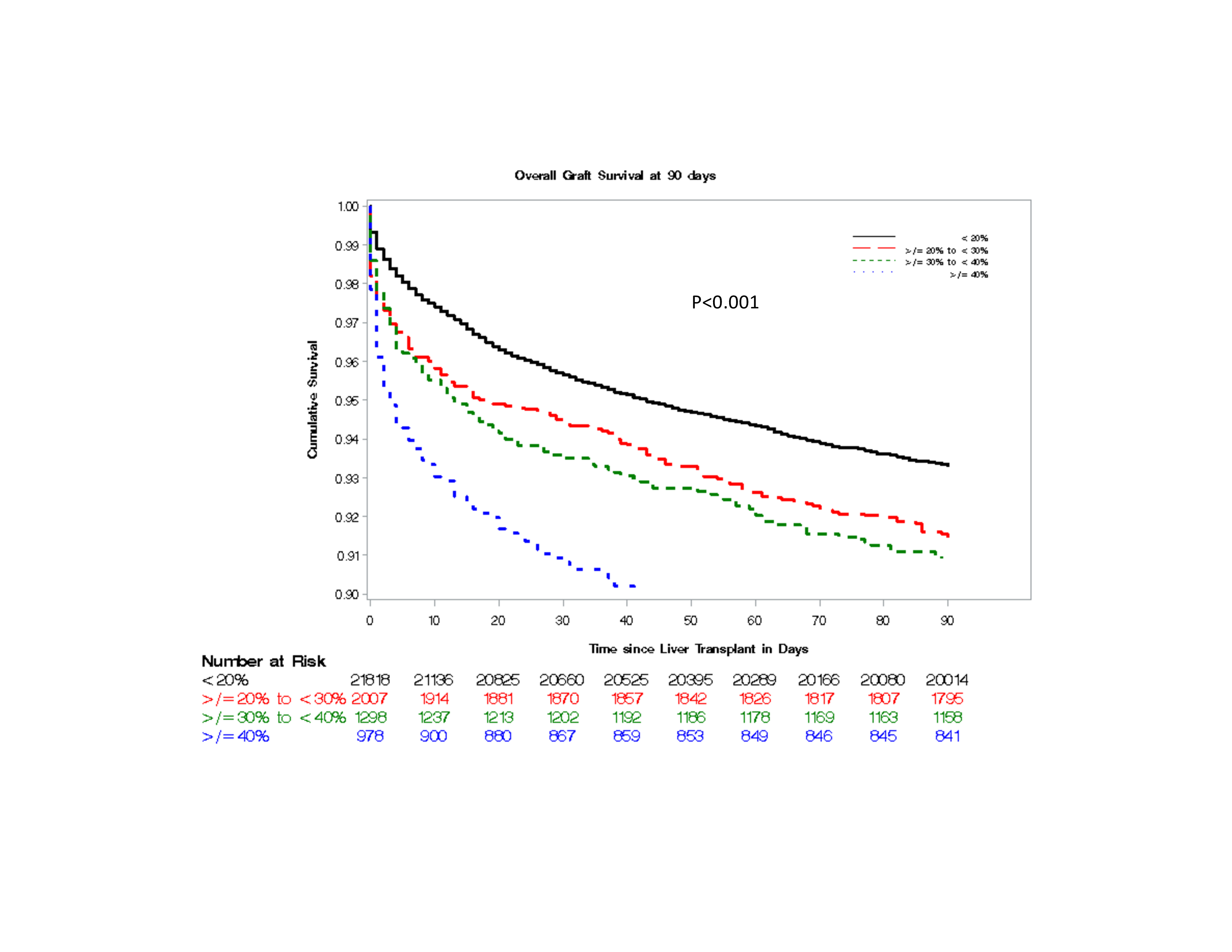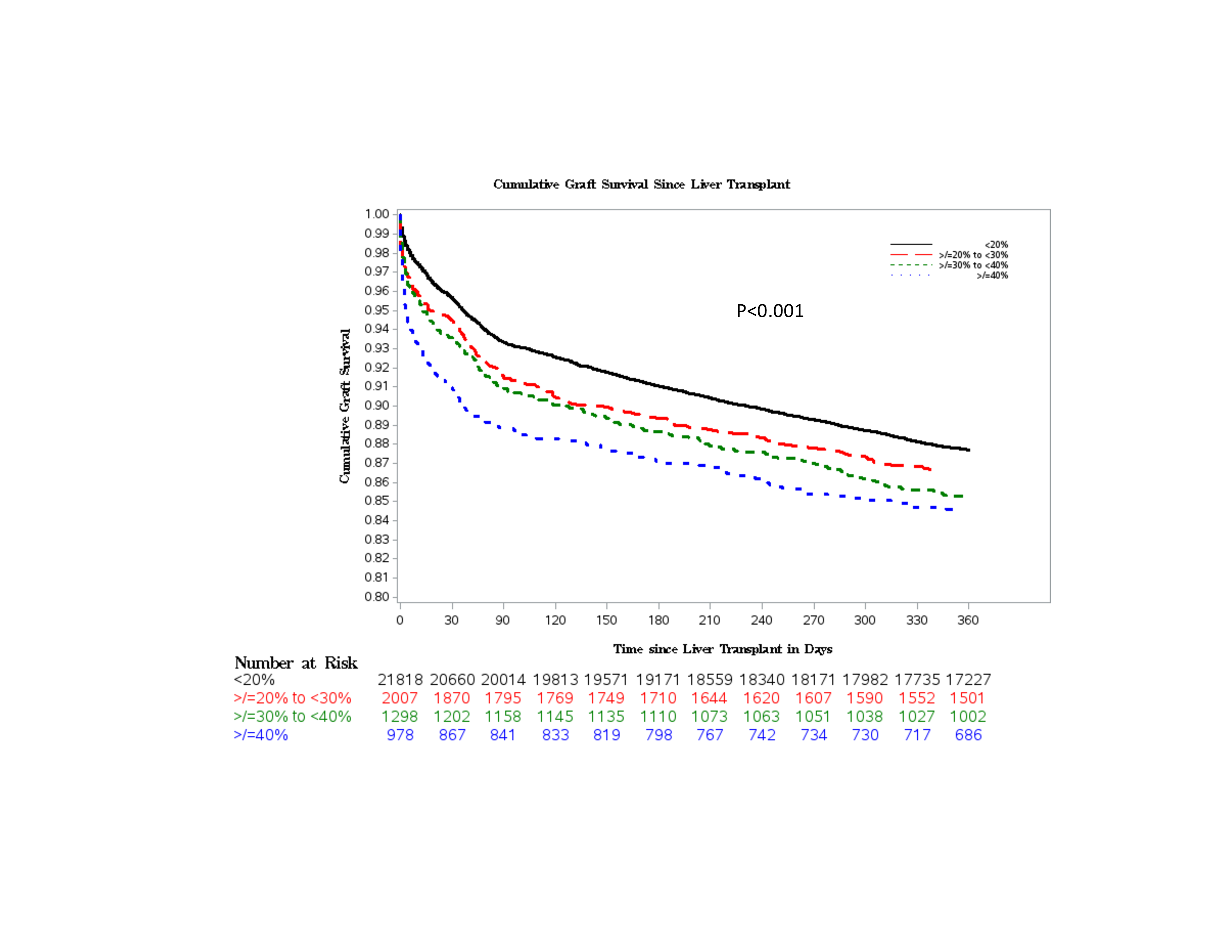Outcomes After Liver Transplantation With Steatotic Grafts: Redefining Acceptable Cutoffs for Moderately Steatotic Grafts
B. L. Da1, J. Satiya2, R. P. Heda3, Y. Jiang4, L. Lau5, A. Fahmy1, A. Winnick1, N. Roth1, E. Grodstein1, P. J. Thuluvath6, A. K. Singal7, T. D. Schiano8, L. W. Teperman1, S. K. Satapathy1
1Liver Disease, Northwell Health, Manhasset, NY, 2Beth Israel Deaconess Medical Center, Boston, MA, 3Tulane Medical Center, Memphis, TN, 4The University of Memphis, Memphis, TN, 5Northwell Health, Manhasset, NY, 6University of Maryland School of Medicine, Baltimore, MD, 7Liver Disease, Avera McKenna University Health Center and Transplant Institute, Manhasset, NY, 8Icahn School of Medicine at Mount Sinai, New York City, NY
Meeting: 2021 American Transplant Congress
Abstract number: 247
Keywords: Donors, unrelated, Liver transplantation, Obesity, Outcome
Topic: Clinical Science » Liver » Liver: Recipient Selection
Session Information
Session Name: Liver Recipient Selection
Session Type: Rapid Fire Oral Abstract
Date: Monday, June 7, 2021
Session Time: 4:30pm-5:30pm
 Presentation Time: 5:00pm-5:05pm
Presentation Time: 5:00pm-5:05pm
Location: Virtual
*Purpose: Graft macro-steatosis can predispose to worse graft survival. Our objective was to redefine acceptable cutoffs for graft steatosis using the national database.
*Methods: Data of 26,103 donors who underwent LT between January 2004 to December 2018 from the United Network for Organ Sharing-Standard Transplant Analysis and Research (UNOS-STAR) database were utilized. A high-risk steatotic (HRS) and low-risk steatotic (LRS) graft was defined as ≥20% and <20% macro-steatosis, respectively. HRS grafts was further classified as grafts with 20-29% (G1S grafts), 30-39% (G2S grafts), and ≥40% steatosis (G3S grafts). Outcomes between groups were compared using Kaplan-Meier curves and multivariate Cox proportional regression analysis.
*Results: Recipients of LRS grafts had a graft (93.3% and 87.7%) and overall survival (95.4% and 90.5%) at 90 days and 1-year. Compared to LRS grafts, G1S, G2S, and G3S grafts had worse graft and overall survival at 90 days and 1-year (P < 0.001). However, there was no difference in graft or overall survival at 90 days or 1-year when G2S grafts were compared to G1S or G3S grafts. After adjusting for significant predictors of graft loss, higher steatosis grades were associated with an increased risk of graft loss. Relative to LRS grafts, G3S grafts had the highest risk of graft loss - aHR 1.38 [1.16-1.63], P < 0.001.
*Conclusions: Although HRS grafts are associated with worse post-LT outcomes compared to LRS grafts, excellent outcomes are seen in the United States due to proper recipient to donor matching. Increasing steatosis grades among HRS grafts is associated with worse graft survival after accounting for other significant predictors of graft loss.
To cite this abstract in AMA style:
Da BL, Satiya J, Heda RP, Jiang Y, Lau L, Fahmy A, Winnick A, Roth N, Grodstein E, Thuluvath PJ, Singal AK, Schiano TD, Teperman LW, Satapathy SK. Outcomes After Liver Transplantation With Steatotic Grafts: Redefining Acceptable Cutoffs for Moderately Steatotic Grafts [abstract]. Am J Transplant. 2021; 21 (suppl 3). https://atcmeetingabstracts.com/abstract/outcomes-after-liver-transplantation-with-steatotic-grafts-redefining-acceptable-cutoffs-for-moderately-steatotic-grafts/. Accessed December 16, 2025.« Back to 2021 American Transplant Congress


